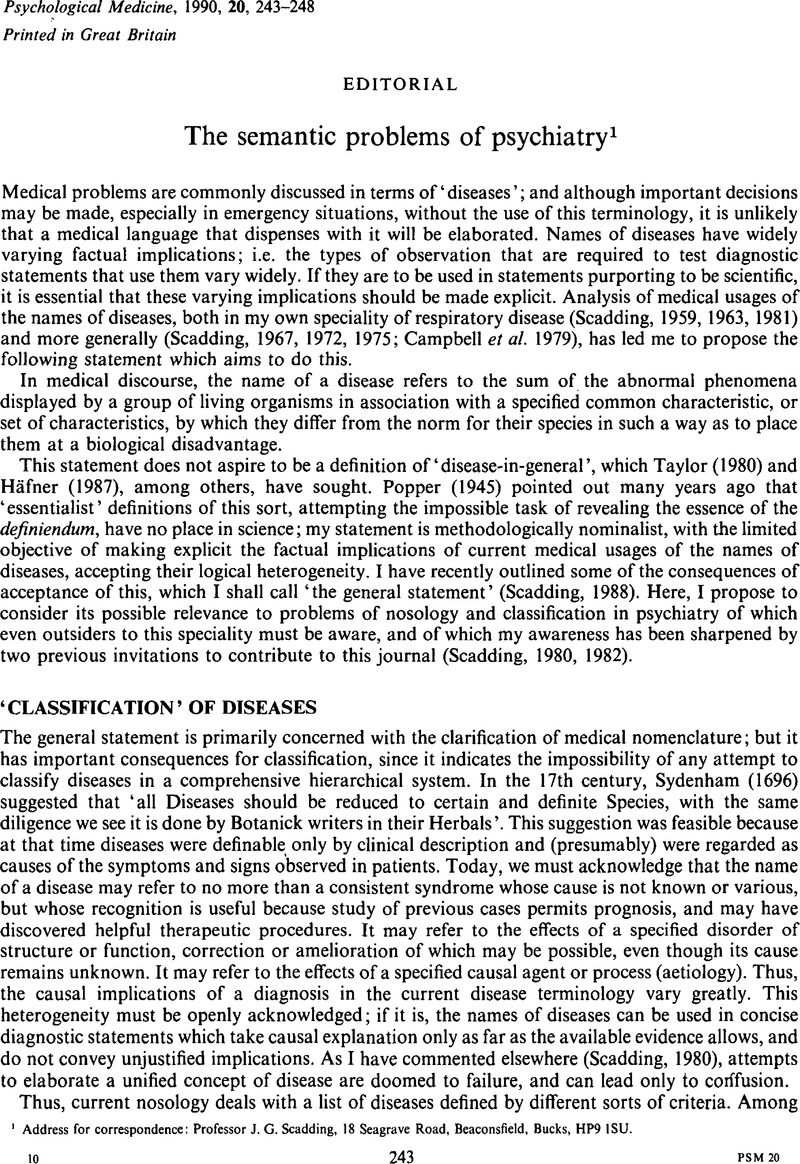Crossref Citations
This article has been cited by the following publications. This list is generated based on data provided by Crossref.
Piccinelli, Marco
and
Ferraris, Aloisia
1992.
La morbilità psichiatrica nella medicina di base: aspetti concettuali e diagnostici.
Epidemiologia e Psichiatria Sociale,
Vol. 1,
Issue. 3,
p.
185.
GUNN, JOHN
1992.
Personality disorders and forensic psychiatry.
Criminal Behaviour and Mental Health,
Vol. 2,
Issue. 2,
p.
202.
Watt, David C.
1992.
Schizophrenia: A Scientific Delusion? By M. Boyle. (Pp. 260; £35.00.) Routledge: London. 1990..
Psychological Medicine,
Vol. 22,
Issue. 2,
p.
526.
Mindham, R. H. S.
Scadding, J. G.
and
Cawley, R. H.
1992.
Diagnoses are not Diseases.
British Journal of Psychiatry,
Vol. 161,
Issue. 5,
p.
686.
Scadding, Guy
1993.
Nosology, Taxonomy and the Classification Conundrum of the Functional Psychoses.
British Journal of Psychiatry,
Vol. 162,
Issue. 2,
p.
237.
Firth, Malcolm T.
1993.
Depression and practice learning in mental health social work.
Journal of Social Work Practice,
Vol. 7,
Issue. 2,
p.
141.
Mindham, R. H. S.
Scadding, J. G.
and
Morgan, H. G.
1993.
McHugh's “A Structure for Psychiatry at the Century's Turn-The View from Johns Hopkins”.
British Journal of Psychiatry,
Vol. 163,
Issue. 4,
p.
542.
Malmgren, H.
and
Lindqvist, G.
1993.
The Semantic Status of Diagnostic Criteria for Organic Mental Syndromes and Disorders in DSM‐III and DSM‐III‐R.
Acta Psychiatrica Scandinavica,
Vol. 88,
Issue. S373,
p.
33.
Beer, M.Dominic
1996.
Psychosis: A history of the concept.
Comprehensive Psychiatry,
Vol. 37,
Issue. 4,
p.
273.
Scadding, JG
1996.
Essentialism and nominalism in medicine: logic of diagnosis in disease terminology.
The Lancet,
Vol. 348,
Issue. 9027,
p.
594.
Sass, Louis A.
2001.
Romanticism, Creativity, and the Ambiguities of Psychiatric Diagnosis: Rejoinder to Kay Redfield Jamison.
Creativity Research Journal,
Vol. 13,
Issue. 1,
p.
77.
Buchanan, Alec
2005.
Descriptive diagnosis, personality disorder and detention.
Journal of Forensic Psychiatry & Psychology,
Vol. 16,
Issue. 3,
p.
538.
Vandereycken, W.
2008.
Handboek psychopathologie deel 1.
p.
5.
Ereshefsky, Marc
2009.
Defining ‘health’ and ‘disease’.
Studies in History and Philosophy of Science Part C: Studies in History and Philosophy of Biological and Biomedical Sciences,
Vol. 40,
Issue. 3,
p.
221.
Kingma, Elselijn
2010.
Paracetamol, Poison, and Polio: Why Boorse's Account of Function Fails to Distinguish Health and Disease.
The British Journal for the Philosophy of Science,
Vol. 61,
Issue. 2,
p.
241.
Boorse, Christopher
2011.
Philosophy of Medicine.
p.
13.
Kingma, E.
2014.
Naturalism about Health and Disease: Adding Nuance for Progress.
Journal of Medicine and Philosophy,
Vol. 39,
Issue. 6,
p.
590.
2014.
Forensic Psychiatry.
p.
801.
Holm, S.
2014.
Disease, Dysfunction, and Synthetic Biology.
Journal of Medicine and Philosophy,
Vol. 39,
Issue. 4,
p.
329.
Saborido, Cristian
and
Moreno, Alvaro
2015.
Biological pathology from an organizational perspective.
Theoretical Medicine and Bioethics,
Vol. 36,
Issue. 1,
p.
83.



